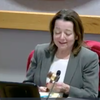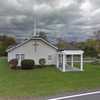Guilderland Planning Board OKs preliminary plan for Foundry Square project
GUILDERLAND — Despite deep reservations about the Foundry Square proposal, the Guilderland Planning Board this week voted to approve the developer’s submitted sketch site plan, allowing the project to move on to the town board.
The town board is now tasked with deciding whether to allow a project whose height and density — issues about which the planning board expressed serious concerns — are not permitted by town code.
The Markstone Group will be seeking approval from the town board, the lead agency for all proposed planned unit developments, known as PUDs, to build two four-story buildings consisting of 285 apartments: 171 two-bedroom units and 114 one-bedroom units.
The developer has agreed to set aside 20 percent of the apartments, 57 units, for workforce housing, which targets individuals earning between 80 and 120 percent of the Guilderland area median income, or about $102,000 per year. Rent plus utilities at 80 percent would be about $2,040, while at 120 percent, monthly payments would be approximately $3,060.
Following a lengthy discussion, the planning board on Sept. 24 adopted the preliminary site plan along with approving a sketch plan report to be sent to the town board that recommends:
— Markstone address town-designated engineer comments made in a Sept. 9 letter;
— As part of the town board’s considering exceeding the town code for project height and density, Markstone provide it with a detailed pro forma, which would show, among other things, the proposed development’s projected cash flow, net revenues, or taxes expected. The document would show, for example, the effect that changes to building height and unit density would have on the bottom line;
— Prior to the town board taking up the code-exceeding requests, Markstone submit an application to the Guilderland Industrial Development Agency to determine if the project would receive any assistance from the IDA. Then, depending on the level of financial support, there may be an opportunity to lower the building height and density.
The report will also include the planning board’s height and density concerns as well as board member Dominic Rigosu’s comments about the project’s design, its visual impact, and integration with the surrounding area.
During the Sept. 24 meeting, Town Planner Kenneth Kovalchik summarized concerns the board had on Sept. 11, during its first review, including issues with various aspects of the project’s layout — for example, the entrance from Western Avenue — access around the buildings, parking, and improvements to Foundry Road.
Project engineer Daniel Hershberg highlighted some of the changes.
— Building setback
Hershberg said, “We heard the comments made at the last meeting about not having enough depth back from Western Avenue to accommodate the exit.”
A line of parking was added in front of the building, placing another 20 feet between the structure and Western Avenue, which Hershberg said, “alleviates some of the thought of looking straight up at a building from Western Avenue”;
— Access
Hershberg said another question was, “How would we handle access behind the buildings, et cetera?”
In the initial sketch plan, the driveway did not go all the way around the buildings “We don’t have the final slope stability analysis yet. So what I did on the plan, I put a slope stability analysis, which I think will be close to what’s done,” Hershberg told board members, “which gave us enough space to do a one-way travel lane behind the buildings in both directions.” Hershberg acknowledged he still needed to work with the fire department to resolve issues related to turning radii and access;
— Parking
The board expressed concerns about the adequacy of the proposed parking.
The apartment complex would need 443 parking spaces to comply with the town’s code; Markstone in its Sept. 11 sketch plan provided only 350. A memo from Kovalchik stated, “If additional parking cannot be provided, it appears that approximately 62 units would have to be removed in order to comply with the parking requirements.” The solution would have been to provide parking underground, but Hershberg said two weeks ago, with a 20-percent workforce housing requirement, the underground parking would make the project economically unfeasible.
By pushing the buildings farther back from Western Avenue, another row of parking was provided. Additional parking to the rear of the buildings was also added due to the driveway now going there. By making the changes, Markstone was able to add another 44 parking spaces.
Board member Christopher Longo raised concerns about the number of spaces being provided. The added spaces bring the total to 394, still 49 short of what town code requires.
“The proposed parking plan is inadequate for the number of units …,” said Longe. “There is no available space to bank additional parking, leaving no room to meet the potential future demand.”
— Remediation and traffic improvements
Part of the proposed project site was once the site of Master Cleaners, a dry-cleaners in business from 1956 through 1996. Albany County took title to the property in 2001, following a tax foreclosure. It was then purchased in September 2011 by the current owner, Charles Bohl Incorporated.
The site was added to the list of state-designated brownfields in 2016; three years later, the state’s Department of Environmental Conservation concluded the site posed a significant threat to the public health and environment, and that cleanup of the soil and groundwater was required
Jeff Marx, an environmental engineer from C.T. Male, told board members on Sept. 11 that the preferred remediation method would be to remove the contaminated earth. Marx said, “DEC is likely going to want to see removal more so than injection,” and that “injection is going to be more of a remedial option when there’s logistic[al] [issues].”
On Sept. 24, Hershberg noted Marx’s recommendation, and said, “We remove all that dirt — there’s a significant amount of earth — we’re not so sure the $2.5 million that we had set aside for brownfield mitigation is going to be enough.”
He then noted the state’s Department of Transportation has made a number of requests for the project.
Hershberg said it wouldn’t be possible for Markstone to truck the contaminated dirt off-site while also responding to DOT’s extensive and expensive traffic improvement requests.
He said DOT “included a whole bunch of issues in there, which go way beyond what was originally on the original proposal.” He noted there had been multiple earlier attempts to build on the site, the most recent failing in part because “they had pretty much the same costs with regard to hazardous waste mitigation and traffic mitigation that this project carries.”
— Height and density
The development’s proposed four-story height and density of 22 units per acre are not allowed by Guilderland’s zoning code but, in seeking a PUD, Markstone is able to ask the town board to approve the height and density requests because PUDs do not have set limits on height or density.
The project density raised questions about the project’s compatibility with the surrounding area and its potential impact on local infrastructure, while it was noted that the proposed density far exceeds “the maximum we’ve had in any zone, in any zoning district in the town,” which was thought to be 16 units an acre, in the town’s transit-oriented development (TOD) district.
Board members felt the four-story height was inconsistent with the surrounding area, which primarily consists of one and two-story structures. Rigosu observed, “The surrounding buildings are predominantly one or two stories tall. Introducing a four-story structure would create a visual disconnect, overshadowing nearby smaller buildings, and make the area feel less cohesive and more disjointed.”
But Hershberg emphasized that the proposed density and scale were necessary for the project to be financially viable, given the costs associated with remediation and required infrastructure improvements.
He said, “If we leave the fourth story off, we’re talking about cutting out about 80 units of housing. That puts us down to 205. At that rate there, I've seen enough to know that it doesn’t work without significant other sources of aid coming into the applicant.”



